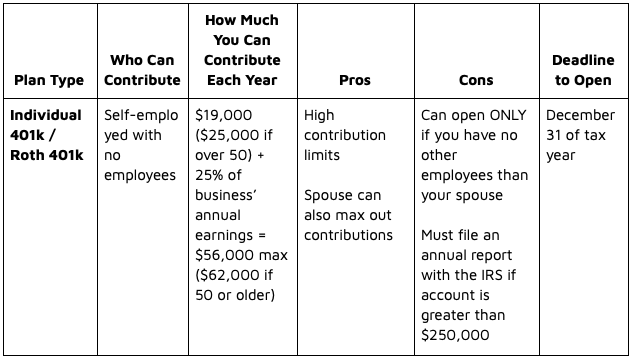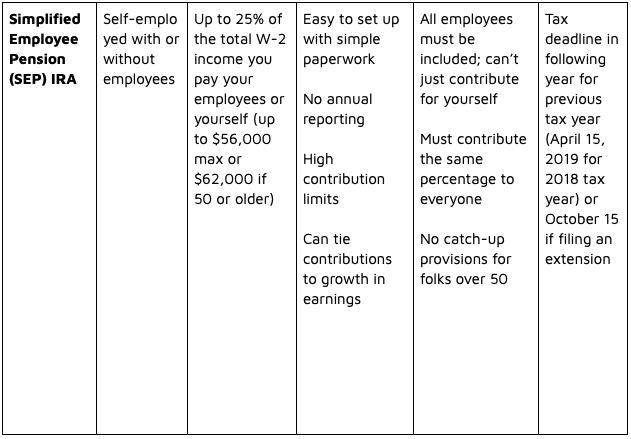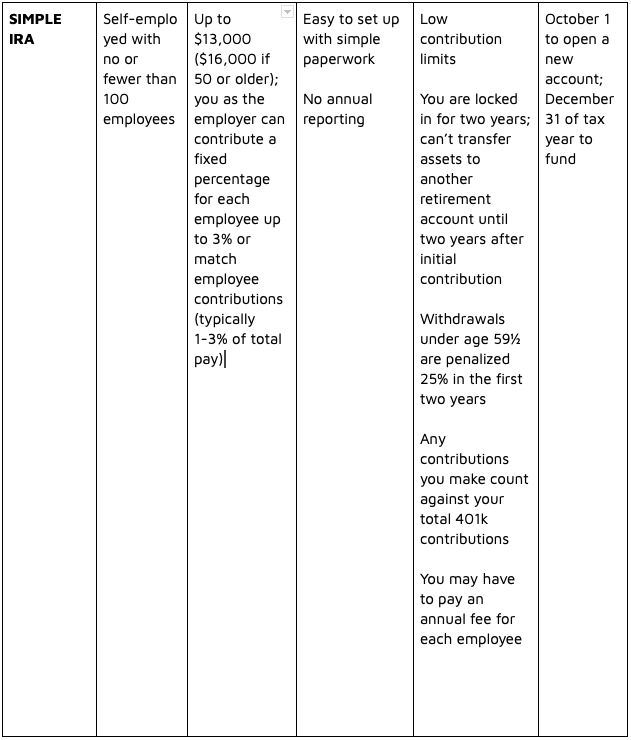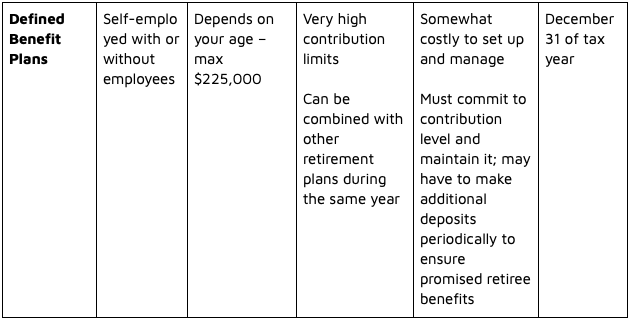Where does saving for retirement fall on your to-do list as a small business owner or self-employed individual?
Without an employer pushing you to save, you are very likely to lose valuable time building your own pension plan. You may even put off retirement planning until it’s too late.
It’s up to you alone to secure your financial future and it may seem overwhelming.
We are about to share four ways that self-employed individuals and small business owners, like you, are saving for retirement so the process will not seem so daunting!
If you’re still on the fence about getting started, let’s begin with the benefits of creating your retirement plan sooner rather than later.

Here’s Why Having a Small-Business Retirement Plan Makes Sense
While you can’t force your employees to save for their future, you can offer a gentle nudge by providing retirement plan options.
After all, statistics show “the average American has less than $4,000 in savings, while 57% of U.S. adults have less than $1,000 to their names.” Retirement savings statistics are even more dismal as “1 in 3 Americans has zero retirement savings and 56% of Americans have less than $10,000 saved for retirement.”
This isn’t enough to fund anyone’s retirement.
On the other hand, a small-business retirement plan:
- Secures your financial future and those of your employees.
- Attracts top talent, especially when combined with a competitive benefits package.
- Keeps your employees happy, which increases your retention rate.
In certain cases, you may even be able to write off your retirement plan contributions as a business expense.
Even if you don’t have a team of employees to think about, signing up for a self-employed retirement plan should still be a top priority.
So let’s discuss the best strategies to create your own plan next.
4 Ways the Self-Employed Can Save for Retirement
The good news is there are several tax-preferred ways to set money aside for your retirement.
Since they can be confusing, we’ve done a side-by-side comparison to help you understand which options are available and their respective pros and cons.
Keep in mind, this list is in no particular order.
#1: Individual 401k or Roth 401k
If you’re a sole proprietor or a self-employed individual without any employees, opting for an Individual 401k or Roth 401k may be a smart option.
Here’s why:
- High contribution limits. You can contribute as much as $19,000 in elective deferrals on earned income ($25,000 if you’re over 50) + 25% of your business’ annual earnings with a max of $56,000 ($62,000 if you’re over 50).
- Your spouse can also max out contributions, so you’ll be earning more and double your tax deferral.
But there are a few downsides to consider, such as:
- Individual 401k plans can only be used if you have no other employees (other than your spouse).
- You must also file an annual report with the IRS if the account totals $250,000 or more.
It is important to understand how a Roth 401k is different from a regular 401k. Salary deferrals you make to a Roth 401k are not tax deductible when you make them and distributions you take in retirement are tax free. In contrast, salary deferrals to a regular 401k are tax deductible when you make them, but you pay ordinary income tax on the distributions in retirement.
Another alternative, Simplified Employee Pension (SEP) IRA, works for both sole proprietors and small business owners with a team of employees.
#2: Simplified Employee Pension (SEP) IRA
Similar to an Individual or Roth plan, the maximum amount an employer can add to a SEP IRA rose in 2019 to $56,000.
This means that up to 25% of the W-2 income you pay your employees or yourself in total is eligible for a retirement contribution as long as it stays under the cap of $56,000 per person per year. Only employers contribute to a SEP IRA. There are no salary deferrals.
And that’s not the only benefit here:
- SEP IRAs are easy to set up and don’t require complex paperwork.
- No annual reporting means you only report once when you receive your earnings.
- Earn more, contribute more (up to the limit). Since you can tie your contributions to your growth in earnings, there’s an incentive for your hard work.
But there are possible drawbacks to a SEP IRA plan, like:
- All of your employees must be included. So you can’t just contribute only to yourself.
- Equal contribution means you must provide the same contribution percentage to every one of your employees.
- No catch-up provision for those over 50 years old to contribute more as they near retirement.
The next small-business retirement plan, a SIMPLE IRA, also shares a few of the same features as the SEP IRA.
#3: SIMPLE IRA
SIMPLE (Savings Incentive Match Plan for Employees) IRAs are also easy to set up and don’t require an endless amount of arduous paperwork.
You also won’t need to file an annual report (Form 5500) with this type of retirement plan either.
Self-employed individuals and those with fewer than 100 employees are eligible to use a Simple IRA retirement plan and contribute up to $13,000 in 2019.
There’s even a $3,000 catch-up contribution addition to the limit for those over 50 to bring their annual total to $16,000.
As the employer, you can choose to contribute in one of two ways: contribute a fixed percentage of each eligible employee’s salary up to 3% or match each employee’s contribution—typically 1-3% of their total pay.
An attractive feature of a SIMPLE IRA for the employee is that 100% of the contributions—including those from the employer—are immediately vested. That means they immediately belong to the employee who can take them with them when they leave the company regardless of how long they’ve been employed there. This may not be beneficial to you, as the employer, since it does not provide an incentive for the employee to stay with your company.
The biggest drawback to this plan is the low contribution limits; and that’s not the only one.
You’re also locked in for two years with this option and you can’t transfer any assets to another retirement account until the two-year anniversary of your initial contribution rolls around.
There’s more:
- Withdrawals made before the age of 59½ are penalized 25% in the first two years
- Any contributions you make count against your total 401k contributions
- You may also have to pay an annual fee for each employee
The final self-employed retirement plan on this list is one that uses a fixed formula.
#4: Defined Benefit Plan
Defined Benefit Plans work well for anyone who is self-employed and generates a high income.
If your goal is to be aggressive with your retirement plan, this may be the best route to take.
This retirement plan works differently in that your plan’s contribution is determined by the stated retirement benefit which can be a flat amount, a percentage of salary, or a unit credit. The annual contribution is capped at $225,000 in 2019.
You can also combine this retirement plan with others in the same year, which are two strong benefits worth considering.
As alluded to earlier, you can write your contributions and any plan fees off as a business expense, which will help reduce the taxes you’ll pay on your high earnings.
The downside here is that these plans can be costly to set up and manage.
You must commit to a contribution level and expect to maintain it for at least five years, which may pose a challenge for individuals with varying income levels throughout the year. You may also have to make periodic deposits to the plan to ensure that it will be able to pay the promised benefit to participating retirees.Since this guide only offers a brief overview of each plan, it pays to get in touch with a professional to see which options are best for your specific situation.




Find the Small-Business Retirement Plan That’s Right for You
Don’t let your overflowing to-do list serve as an excuse to put off retirement planning.
The first step is finding a self-employed retirement plan or small-business retirement plan best suited for your needs. And if you have employees, you can also set up a retirement plan with them in mind too.
An experienced professional will help you decide your best options and assist you with the setup and management of your plan. Then all you have to do is contribute to secure the future you envision for retirement.
To find the best self-employed retirement plan for your needs, reach out to our team today!

